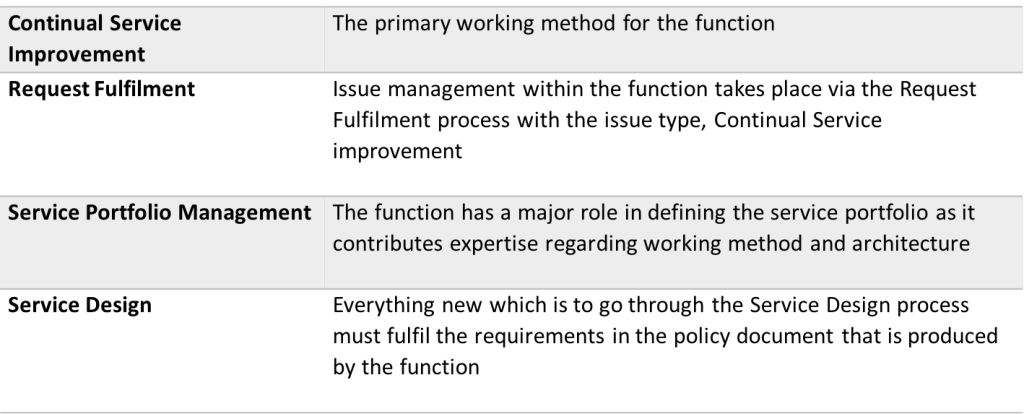What distinguishes an effective group or organization from others is that it has a unity, a common approach and a common working methodology. The primary aim of the Service Management Office function is to create and administer the common platform for the IT organization as a whole, so that the energy is focused on producing, instead of discussing who should do what and in which way it should be done.
The bigger the organization, the greater the need for a common working methodology. It is very easy to build ”downpipes” or ”silos” in large organizations. In other words, departments which lock themselves operationally into their own part of the organization without taking account of, or deriving benefit from, what other parts already have implemented. Such organizations often ends up referring to or blaming mistakes on other parts of the organization. Such behavior is not effective.
A central function is needed to govern the working method, assist in dismantling walls and getting the IT organization as a whole to work together. A fundamental requirement for this to succeed is that this function has the support of and mandate from the senior management within IT.

Purpose
The purpose of the function is to bring together common structural questions so that all parts of the IT organization work in a similar way and according to the same architecture. If necessary, large and medium-sized IT organizations can divide up the function into one section for service management and one for architecture.


Responsibility
The function is directly subordinate to the IT Steering Group and should provide knowledge about working method and architecture at the strategic level. It is the function’s task to comment on and promote continual service improvements within the area. The function is also responsible for drafting the policy documents which have to be approved at strategic level and which govern work within the IT organization.
As the aim of the function is to coordinate and standardize the working method throughout the IT organization, it is important that all processes, methods and parameters are located within the responsibility for the function.
Activities and working method
In a large IT organization where process owner and architect are full-time roles, it is simplest that the Architecture and Service Management Office function constitute one organizational unit. In smaller IT organizations, work within the function is performed regularly, for example, once per week.
The activities consist of continually measuring, following up and improving the architecture and the service management within the IT organization. This is facilitated through using the service management and ticket management in the Continual Service Improvement process.
Input
Input to the function consists of reports, measurement data, errors detected and proposals for improvements or requests from the IT organization as a whole. In order to structure all the issues that are received, the Continual Service Improvement process is used.
Output
The function’s primary output is a complete model which describes the entire IT organization’s service management and architecture. The fact that this exists is meaningless if it is not used, which means that the function must continually document models and architecture, and work to inform, train and support usage within the IT organization. This means that output from the function also comprises training courses, quick guides, information meetings and personal support of staff concerned.
Documentation
All documents produced by the function must be available in a business system. The most important documents are:
- Service structure
- Governance model for the IT organization
- Roles and responsibility within the IT organization
- Process documentation
- Architecture documentation
- IT policy containing:
- IT security policy
- Policy for processes and service management
- Policy for software
- Policy for infrastructure
Relationships with other processes and functions
Service Management Office has links to many other processes and functions. The most common are listed here:


